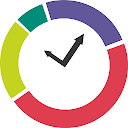MyFitnessPal for Android
- Description
MyFitnessPal for Android has been on the Play Store since the early 2010s, and even in mid‑2025 it still feels like the most complete “all‑in‑one” calorie and fitness tracker you can download for free. The installer is small, under 60 MB, but the real power sits in a cloud database of roughly 19million food entries. When you launch the app for the first time, a short setup wizard asks your age, height, weight, basic activity level, and whether you want to lose, gain, or hold steady. From those few answers, it builds a daily calorie budget and breaks it into protein, fat, and carbohydrate targets. The number is not carved in stone, and anyone who prefers a custom macro split can edit it later in settings.
Logging meals is straightforward. Tap the blue plus sign, pick breakfast, lunch, dinner, or snack, and start typing. The search bar finds branded items, chain‑restaurant meals, and plenty of homemade dishes that other users have entered. A barcode scanner handles packaged food in seconds, and a newer label‑scan tool reads nutrition panels straight from a photo. Once food is logged, the app subtracts its calories from your daily allowance and nudges colored bars that show how close you are to each macro limit. By the third day, the diary starts suggesting your usual items so you can record them with a single tap, saving time if you eat the same oats or yogurt every morning.
Exercise lives on its own tab. You can type runs, sets, yoga sessions, or pick them from a long list. Most people, though, simply connect a wearable and let the watch do the counting. MyFitnessPal syncs with Google Fit, Samsung Health, Garmin, Fitbit, Oura, and several smaller brands. Whatever calories the watch says you burned come back to the food diary as extra room to eat. Strength workouts earned a small upgrade this year: the microphone listens for the clink of a barbell and counts repetitions automatically. It is not perfect, but it means less fiddling with a phone between sets.
The free version remains functional, yet it shows banner ads under the diary and full‑screen ads after a handful of entries. Premium removes those interruptions and unlocks extra charts that break down macros by meal, plus a recipe importer that pulls nutrition from almost any web page. Premium now costs about €13 per month or €80per year, a fee many long‑time users accept just to eliminate the ads and gain a weekly nutrition‑coach email that highlights their biggest calorie sources and suggests small swaps.
Strengths are easy to spot. The food database is enormous, covering everything from local street snacks to boutique protein powders. Barcode and label scanning cut logging time to seconds. The app integrates with nearly every common wearable, so calories eaten and calories burned finally live in one place. Community forums and recipe boards give beginners a social nudge, although the chatter can feel busy. Weaknesses are mostly in the business model and data hygiene. Some user‑submitted foods carry typos, so it pays to double‑check unfamiliar entries. Features that used to be free — meal reminders, advanced graphs, and the new AI meal plan — now hide behind the paywall. And while the company keeps data on European servers and anonymizes trends, third‑party research partners still receive stripped‑down logs, a fact that bothers privacy‑first athletes.
Battery drain is minor unless you let the app sync steps all day. Turning that option off and syncing only when you open the diary saves noticeable power on older phones. Data use is tiny for individual logs, but will grow if you scan barcodes at every meal over mobile rather than Wi‑Fi.
In practice, MyFitnessPal remains the easiest way to learn what you actually eat in a day and how that matches your goals. If ads do not bother you, the free tier gives nearly every basic tool you need. If ads drive you crazy, or you want deeper nutrient charts, the paid plan may be worth the outlay. Either way, the app still strikes a rare balance: powerful enough for athletes, gentle enough for first‑timers, and quick enough that logging a meal rarely takes more than thirty seconds.


Comments
Please add a comment explaining the reasoning behind your vote.